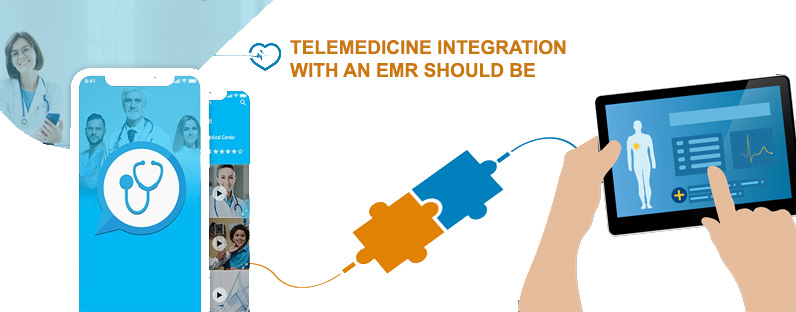Telemedicine is a means of connecting providers with remote or underserved patients. Proper telemedicine systems are necessary to be able to conduct clinical examinations on a patient remotely. Typically these telemedicine systems include an encounter management platform, specialized medical devices, and network video conferencing. It is also important that the best telemedicine systems pair seamlessly with other IT solutions. Telemedicine and EMR made healthcare more efficient and dynamic. Here we will discuss how Telemedicine EMR Integration should be for your organization.
Online technology in the medical industry is making healthcare more accessible, affordable, and easier to use than ever before. If you use EMR, you might have already realized its ability to coordinate care for patients, store their medical data and track their progress. If you use telemedicine software, you might be already aware of its numerous advantages including increased flexibility, efficiency and accuracy. But you may not have realized that when these two systems are integrated, they produce a powerhouse of clinical efficiency and that is why the integration of telemedicine and EMR is regarded as one of the main identities of a good patient-centred medical home (PCMH).
Table of Contents
ToggleTelemedicine Integration with an EMR
Here are some finer aspects of the integration and how it can be beneficial-
1. Minimize Duplicate Records
A telemedicine solution integrated into an EHR helps minimize duplicate records in the same vein. Just think about how many details and medical history you have to search for several patients already. It can make it hard to zero in on the information you need.
Jumping on board with integrated telemedicine solutions helps cut through the noise by streamlining record collection and eliminating duplicate data from virtual visits.
2. Proper Documentation of Telemedicine Visits
Telemedicine app enables you to improve the quality of patient care but this improvisation can be effective only if all the telemedicine visits are documented properly. Entire videos of each virtual check-up need to be recorded and synced with the patient’s previous records so that the health progress can be tracked and analyzed whenever required. If EMR development is integrated with telemedicine software, this work can be done seamlessly. As a result, you don’t have to worry about missing any important data from being recorded or finding a particular record from the huge amount of stored data. The storing becomes easy, the data is organized, and if you’ve to look back to any old record, finding it is easy too.
3. Patients are less hassled
There’s a difference between the way you and your staff use EMR applications and the way patients can use them. It is important to know what kind of access can be useful to patients and it needs to be ensured that the access is easy. If EMR applications are merged with telemedicine systems, the process of accessing virtual care can be made easier for the patients. This is a big contribution because these systems have the potential to benefit physicians, staff, pharmacists as well as patients. So the integration helps in making the best use of each of the technologies and ensures every user can get the intended benefits.
4. The Right Telemedicine provider for your EMR
Not all providers available in the market can be trusted because when you’re dealing with sensitive data related to a patient’s health, you need to have reliable technology. You cannot afford to compromise on the details and accuracy for the sake of benefits in return. Also, you may prefer to have some changes in the workflow despite the integration, to suit the workings of your healthcare facility. To ensure this, you must go for a provider who assures seamless integration with complete reliability.
5. Streamline workflow
Because much of your practice data lives in your EHR, your office workflow is likely to be built around the system-at least in part. Instead of only a few extra clicks and steps inside your EHR, using a completely different telehealth software system or the program will create a whole new method to manage.
6. Improving Data Collection with Telehealth
EMR integrations can be extremely beneficial from a reporting and analytical perspective, in particular for reporting and accounting reconciliations for all commercial payers as well as for Medicare and Medicaid. When a telehealth encounter (i.e. remote patient monitoring or virtual visitation) integrates with the EMR, facilitating data collection and health system billing. Reporting is particularly relevant with the recent improvements to the CMS for virtual check-ins, online patient tracking and internet consultations. Telehealth encounters can now be reimbursed, providing a huge opportunity for providers around the world, while also providing a need for quality and accurate reporting. Bidirectional telehealth EMR integrations are helping organizations to meet this need.
7. Security and ease of use
EMRs are already leveraged to reduce administrative overhead and the possibility of human errors. Paired, the two technologies, together with telemedicine, make it easier for healthcare professionals to manage patient encounters, control privacy and reduce the possibility of data entry mishaps.
The UI during a telemedicine encounter doesn’t just make it easy to store patient data but also works to eliminate misplaced or lost documents during the charting process. That way a doctor can quickly prepare for the next patient without worrying about any mistakes. The best telemedicine app development platforms come with robust security measures to ensure the patient encounter is private and well-protected from third parties or sources of compromised privacy. In this way, exchanging information in real-time is as easy as storing the data for later reference in an EMR.
Planning for Telemedicine EMR integration?
Our experts can help you with cost-effective solution
Conclusion
Integrating telemedicine with EMR simplifies healthcare operations, reduces errors, and enhances patient care. However, integrating EMR with telemedicine solution requires various things to consider. We hope this guide helps you understand how to incorporate EMR with telemedicine and why choosing the right provider is essential for healthcare organizations to let the integration go smoothly. Now, it’s your turn to hire experienced developers and let the professionals seamlessly integrate EMR.
FAQs
Q1. Why is it essential to integrate telemedicine with EMR?
Integrating telemedicine with EMR gives a smoother and brighter healthcare experience. It eliminates duplicate records, keeps everything organized, and helps providers focus on what matters most—patient care. It eliminates duplicate records, keeps everything organized, and helps providers focus on what matters most, i.e., patient care.
Q2. How does integration benefit patients?
After integrating EMR with telemedicine, patients can access virtual care, enjoy seamless communication with their doctors, and rest assured that their health records are well-managed and up-to-date.
Q3. What should healthcare organizations consider when choosing a telemedicine provider?
They should look for reliable technology, strong security features, seamless EMR integration, and workflow customization options.
Q4. Is telemedicine-EMR integration secure?
Yes, most systems have advanced security measures to protect patient data and ensure privacy.
Q5. What are the challenges of telemedicine-EMR integration?
Common challenges are compatibility issues, costs, staff training, and ensuring data security during the setup.





















